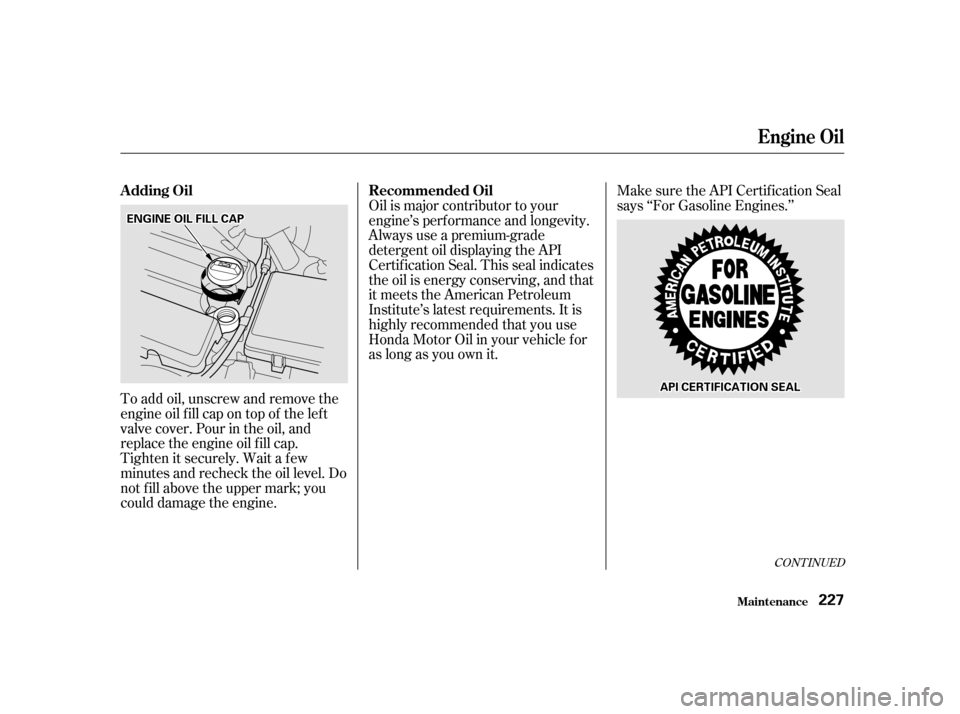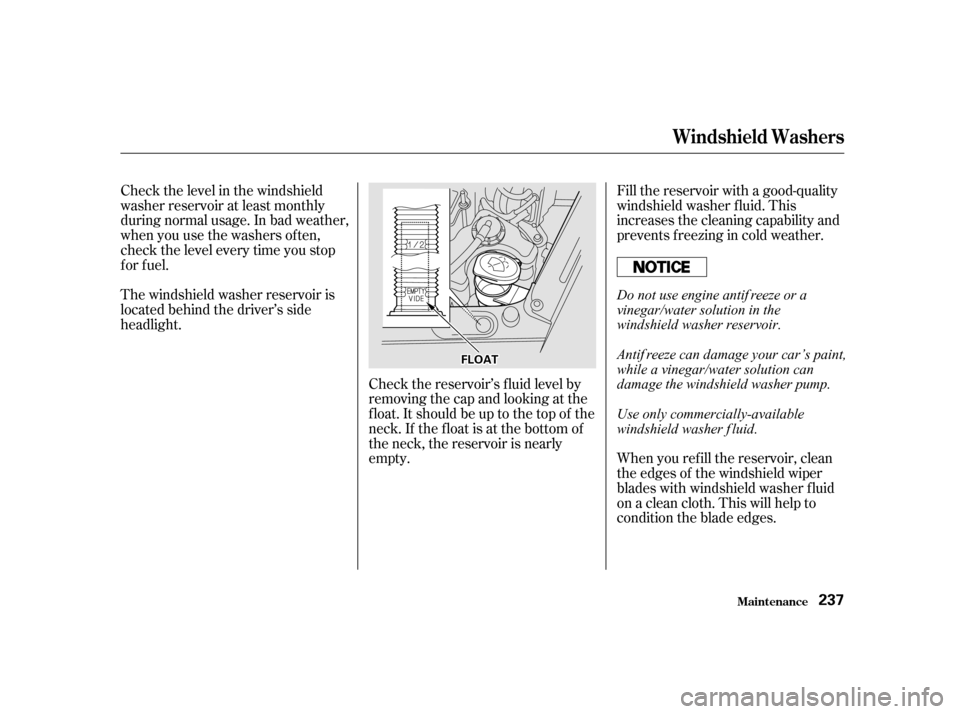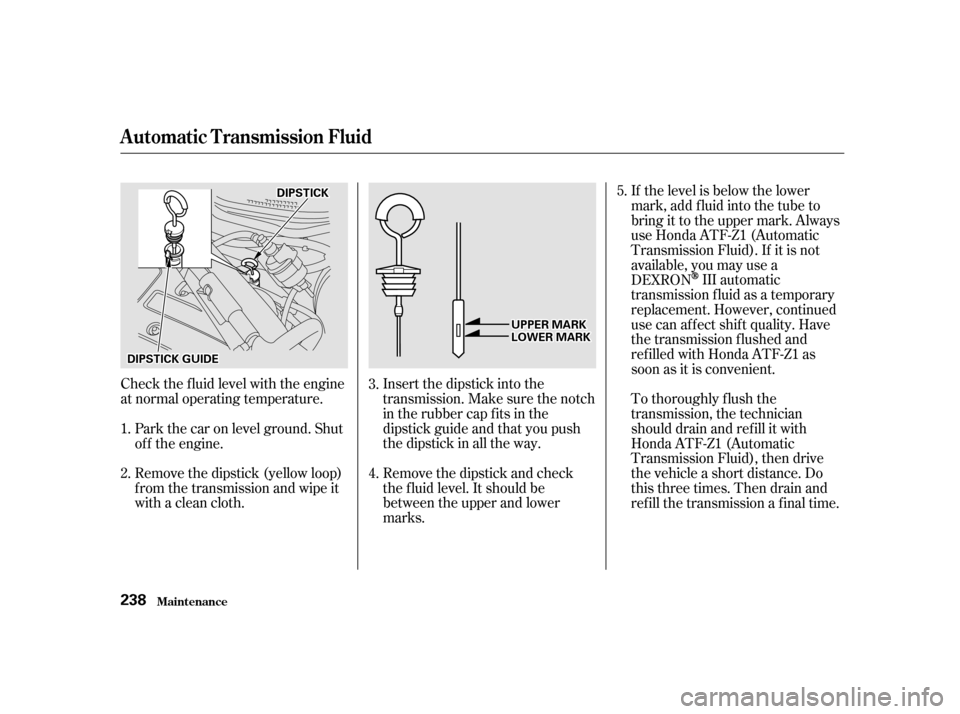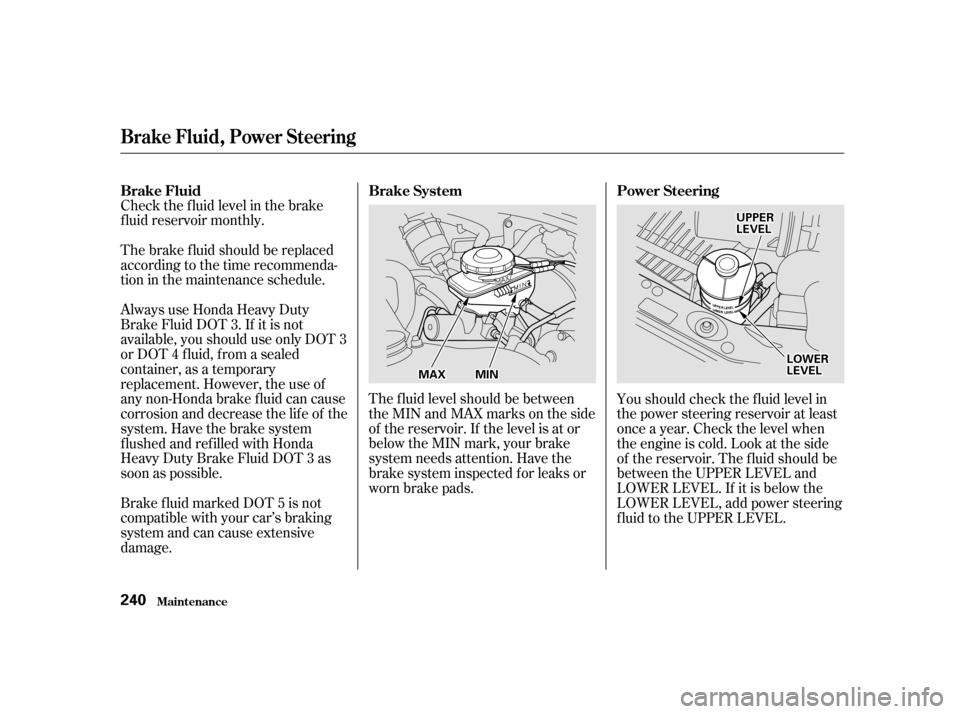check engine Acura RL 2002 3.5 Owner's Guide
[x] Cancel search | Manufacturer: ACURA, Model Year: 2002, Model line: RL, Model: Acura RL 2002Pages: 343, PDF Size: 4.66 MB
Page 230 of 343

To add oil, unscrew and remove the
engine oil f ill cap on top of the lef t
valve cover. Pour in the oil, and
replace the engine oil f ill cap.
Tighten it securely. Wait a f ew
minutes and recheck the oil level. Do
not f ill above the upper mark; you
could damage the engine.Oil is major contributor to your
engine’s perf ormance and longevity.
Always use a premium-grade
detergent oil displaying the API
Certif ication Seal. This seal indicates
the oil is energy conserving, and that
it meets the American Petroleum
Institute’s latest requirements. It is
highly recommended that you use
Honda Motor Oil in your vehicle f or
as long as you own it.
Make sure the API Certif ication Seal
says ‘‘For Gasoline Engines.’’
CONT INUED
A dding Oil
Recommended Oil
Engine Oil
Maint enance227
E EN
NG GIINNE E O
OIILL F
FIILLL L C
CAA P
P
A
AP
PI
IC
CE ER
RT TI
IFFI ICCA A T
TI
IOON N S
SEEA
A L
L
01/09/28 20:02:34 31SZ3660_230
Page 233 of 343

Let the engine run f or several
minutes and check the drain bolt
and oil f ilter f or leaks.
Turn of f the engine, let it sit f or
several minutes, then check the oil
level. If necessary, add oil to bring
the level to the upper mark on the
dipstick.
Install a new oil f ilter according to
instructions that come with it.
Put a new washer on the drain bolt,
then reinstall the drain bolt.
Tighten it to:
Refill the engine with the recom-
mended oil.
Engine oil change capacity
(including f ilter):
Replace the engine oil f ill cap.
Start the engine. The oil pressure
indicator light should go out within
f ive seconds. If it does not, turn of f
the engine and reinspect your
work.
6. 7.
8.
9.
4.
5.
Engine Oil
Maint enance230
33 lbf·ft (44 N·m , 4.5 kgf·m)
4.9 US qt (4.6
, 4.0 Imp qt)
Improper disposal of engine oil can be
harmf ul to the environment. If you
change your own oil, please dispose of
the used oil properly. Put it in a sealed
container and take it to a recycling
center. Do not discard it in a trash bin
or dump it on the ground.
01/09/28 20:03:03 31SZ3660_233
Page 234 of 343

If the coolant level in the reserve
tank is at or below the MIN line, add
coolant to bring it up to the MAX line.
Inspect the cooling system f or leaks.
The coolant you add should always
be a mixture of 50 percent antif reeze
and 50 percent water. Never add
straight antif reeze or plain water.If the reserve tank is completely
empty, you should also check the
coolant level in the radiator.
Make sure the engine and radiator
are cool.
Always use Honda All Season
Antif reeze/Coolant Type 2. This
coolant is pre-mixed with 50 percent
antif reeze and 50 percent water. It
does not require any additional
mixing.
If it is not available, you may use
another major-brand non-silicate
coolant as a temporary replacement.
Make sure it is a high-quality coolant
recommended f or aluminum engines.
However, continued use of any non-
Honda coolant can result in
corrosion, causing the cooling
system to malf unction or f ail. Have
the cooling system f lushed and
ref illed with Honda antif reeze/
coolant as soon as possible.
1.
CONT INUED
A dding Engine Coolant
Cooling Syst em
Maint enance231
R RE
ES
SE ER
RV V E
E T
TA
A N
NK K
Removing the radiator cap
while the engine is hot can
cause the coolant to spray out,
seriously scalding you.
Always let the engine and
radiator cool down before
removing the radiator cap.
01/09/28 20:03:12 31SZ3660_234
Page 239 of 343

Install the radiator cap, and
tighten it fully.
If necessary, f ill the reserve tank
to the MAX mark. Install the
reserve tank cap.
Remove the radiator cap. Pour
coolant into the radiator up to the
base of the f iller neck and into the
reserve tank up to the MAX mark.
Start the engine and hold it at
1,500 rpm until the cooling f an
comes on. Turn of f the engine.
Check the coolant level in the
radiator and add coolant if needed. Install the engine cover. First
tighten the two bolts on the front
of the engine cover, then tighten
the three nuts on the engine cover.
Tightening torque:
Install the radiator cap, and
tighten it to the first stop.
Start the engine and let it run until
the radiator cooling f an comes on
at least twice. Then stop the
engine.
Fill the reserve tank to the MAX
mark. Install the reserve tank cap.
Check the level in the radiator,
add coolant if needed.
12. 11. 13.
14.
15.
16.
17. 18.
19.
Cooling Syst em
Maint enance236
R RE ES
SE ER
RV V E
E T
TA
A N
NK K
F
Fi
illll u
u p
p t
too h
he
erree F
FIILLL LEE R
R N
NEEC
CK K
7 lbf·ft (9.8 N·m , 1.0 kgf·m)
01/09/28 20:04:03 31SZ3660_239
Page 240 of 343

Fill the reservoir with a good-quality
windshield washer f luid. This
increases the cleaning capability and
prevents f reezing in cold weather.
Check the level in the windshield
washer reservoir at least monthly
during normal usage. In bad weather,
when you use the washers of ten,
check the level every time you stop
for fuel.
The windshield washer reservoir is
located behind the driver’s side
headlight.
Check the reservoir’s f luid level by
removing the cap and looking at the
f loat. It should be up to the top of the
neck.Ifthefloatisatthebottomof
the neck, the reservoir is nearly
empty. When you ref ill the reservoir, cleanthe edges of the windshield wiper
blades with windshield washer fluid
on a clean cloth. This will help to
condition the blade edges.
Windshield Washers
Maint enance237
F FLLOOA AT
T
Do not use engine antif reeze or a
vinegar/water solution in the
windshield washer reservoir.
Antif reeze can damage your car’s paint,
while a vinegar/water solution can
damage the windshield washer pump.
Use only commercially-available
windshield washer f luid.
01/09/28 20:04:10 31SZ3660_240
Page 241 of 343

Check the f luid level with the engine
at normal operating temperature.Remove the dipstick (yellow loop)
f rom the transmission and wipe it
with a clean cloth. Insert the dipstick into the
transmission. Make sure the notch
in the rubber cap f its in the
dipstick guide and that you push
the dipstick in all the way.
Remove the dipstick and check
the f luid level. It should be
between the upper and lower
marks.
Park the car on level ground. Shut
of f the engine. If the level is below the lower
mark, add f luid into the tube to
bring it to the upper mark. Always
use Honda ATF-Z1 (Automatic
Transmission Fluid). If it is not
available, you may use a
DEXRON
III automatic
transmission f luid as a temporary
replacement. However, continued
use can affect shift quality. Have
the transmission f lushed and
ref illed with Honda ATF-Z1 as
soon as it is convenient.
To thoroughly f lush the
transmission, the technician
should drain and ref ill it with
Honda ATF-Z1 (Automatic
Transmission Fluid), then drive
the vehicle a short distance. Do
this three times. Then drain and
ref ill the transmission a f inal time.
1.
2. 3.
4.5.
Automatic Transmission Fluid
Maint enance238
D D
I
IPP S
ST TI
ICCK K G
GUUIIDD E
E D
D
I
IPP S
ST TI
ICCK K
U
UPPP
PE
ER
R M
M A
AR
RKK
L
LO OW WE ER
R M
M A
AR
RKK
01/09/28 20:04:21 31SZ3660_241
Page 243 of 343

The f luid level should be between
theMINandMAXmarksontheside
of the reservoir. If the level is at or
below the MIN mark, your brake
system needs attention. Have the
brake system inspected f or leaks or
worn brake pads.
Check the f luid level in the brake
f luid reservoir monthly.
The brake f luid should be replaced
according to the time recommenda-
tion in the maintenance schedule.
Always use Honda Heavy Duty
Brake Fluid DOT 3. If it is not
available, you should use only DOT 3
or DOT 4 f luid, f rom a sealed
container, as a temporary
replacement. However, the use of
any non-Honda brake fluid can cause
corrosion and decrease the lif e of the
system. Have the brake system
f lushed and ref illed with Honda
Heavy Duty Brake Fluid DOT 3 as
soon as possible.
Brake f luid marked DOT 5 is not
compatible with your car’s braking
system and can cause extensive
damage.
You should check the f luid level in
the power steering reservoir at least
once a year. Check the level when
the engine is cold. Look at the side
of the reservoir. The f luid should be
between the UPPER LEVEL and
LOWER LEVEL. If it is below the
LOWER LEVEL, add power steering
f luid to the UPPER LEVEL.
Brake System Power Steering
Brake Fluid
Maint enance
Brake Fluid, Power Steering
240
M M I
INN
M
M A
AX
X L
LO
OW WE ER
R
L
LE E V
V E
EL
L
U
UP
PP
PE
ER
R
L
LE E V
V E
EL
L
01/09/28 20:04:43 31SZ3660_243
Page 254 of 343

Run the air conditioning at least once
a week during the cold weather
months. Run it f or at least ten
minutes while you are driving at a
steady speed with the engine at
normal operating temperature. This
circulates the lubricating oil con-
tained in the ref rigerant.If the air conditioning does not get as
cold as before, have your dealer
check the system. Recharge the
system with Ref rigerant HFC-134a
(R-134a). (See Specif ications on page
.)
Periodically check the engine’s
radiator and air conditioning
condenser f or leaves, insects, and
dirt stuck to the f ront surf ace. These
block the air f low and reduce cooling
ef f iciency. Use a light spray f rom a
hose or a sof t brush to remove them. Your car’s air conditioning is a sealed
system. Any major maintenance,
such as recharging, should be done
by a qualif ied mechanic. You can do
a couple of things to make sure the
air conditioning works ef f iciently. 312
A ir Condit ioning Syst em
Maint enance251
A A I
IRR C
COON NDDI
ITT I
IOON NIINNG G C
COON NDDE
EN
NS SEER
R
Whenever you have the air conditioning
system serviced, make sure the service
f acility uses a ref rigerant recycling
system. This system captures the
ref rigerant f or reuse. Releasing
ref rigerant into the atmosphere can
damage the environment.
The condenser and radiator f ins bend
easily. Only use a low-pressure spray
or sof t-bristle brush to clean them.
01/09/28 20:06:26 31SZ3660_254
Page 284 of 343

This section covers the more-
common problems that motorists
experience with their vehicles. It
gives you inf ormation about how to
safely evaluate the problem and what
to do to correct it. If the problem has
stranded you on the side of the road,
you may be able to get going again.
If not, you will also f ind instructions
on getting your car towed.......................
Compact Spare Tire .282
....................
Changing a Flat Tire .283
..........
If Your Engine Won’t Start .288
Nothing Happens or theStarter Motor Operates ........................
Very Slowly .288
The Starter Operates ................................
Normally .289
................................
Jump Starting .290
............
If Your Engine Overheats .293
.........
Low Oil Pressure Indicator .295
..........
Charging System Indicator .296
.......
Malf unction Indicator Lamp .297
...............
Brake System Indicator .299
..................
Closing the Moonroof .300
..............................................
Fuses .301
..........
Checking and Replacing .302
......................
Emergency Towing .306
Taking Care of the Unexpected
T aking Care of t he Unexpect ed281
01/09/28 20:11:13 31SZ3660_284
Page 291 of 343

Diagnosing why your engine won’t
start f alls into two areas, depending
on what you hear when you turn the
key to START (III):You hear nothing, or almost
nothing. The engine’s starter
motor does not operate at all, or
operates very slowly.
You can hear the starter motor
operating normally, or the starter
motor sounds like it is spinning
f aster than normal, but the engine
does not start up and run. When you turn the ignition switch to
START (III), you do not hear the
normal noise of the engine trying to
start. You may hear a clicking sound
or series of clicks, or nothing at all.
Check these things:
Check the transmission interlock.
The transmission must be in Park
orNeutralorthestarterwillnot
operate.
Sliptheholeatthetopof thejack
over the bracket in the trunk well.
Turn the jack’s end bracket to lock
it in place. Store the tool kit back
in its place.
Close the trunk lid. Store the center cap and spacer
basket in the trunk. Make sure the
center cap will not get scratched
or damaged. Unclip the hook f rom the trunk lid
and lower the trunk f loor.
Your car has the Immobilizer
System. You should use a
properly-coded master or valet key
to start the engine (see page ).
A key that is not properly coded
will cause the immobilizer system
indicator in the dash panel to blink
rapidly.
19.
20.
21.
22. 75
Changing a Flat Tire, If Your Engine Won’t Start
T aking Care of t he Unexpect ed
If Your Engine Won’t Start Nothing Happens or the Starter
Motor Operates Very Slowly
288
Loose items can fly around the
interior in a crash and could
seriously injure the occupants.
Store the wheel, jack, and tools
securely before driving.
01/09/28 20:12:29 31SZ3660_291